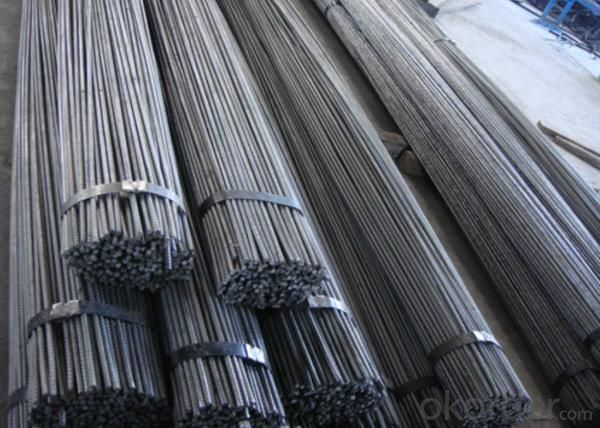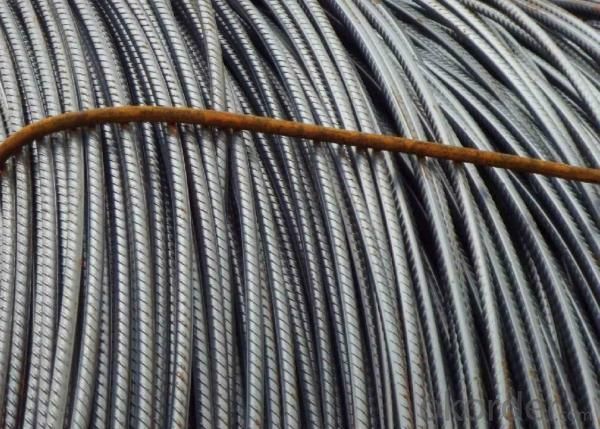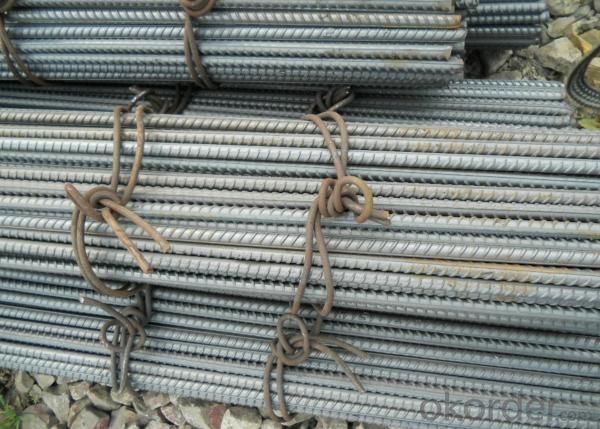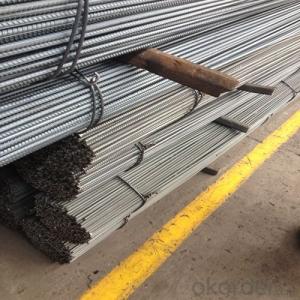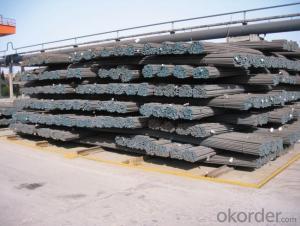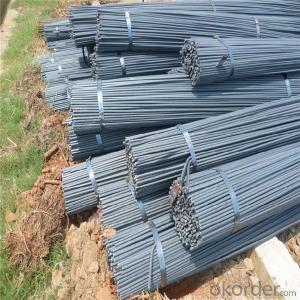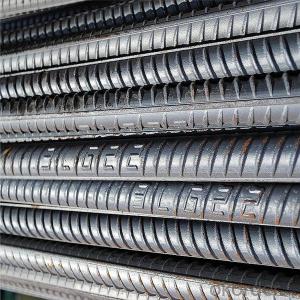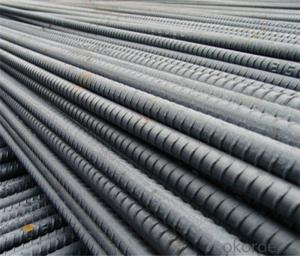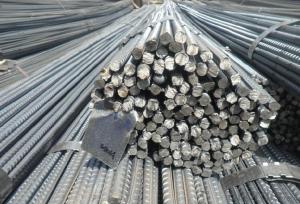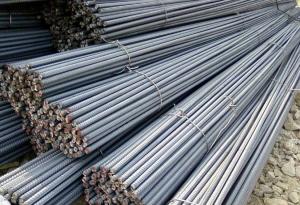Construction Deformed Steel Rebar
- Loading Port:
- China Main Port
- Payment Terms:
- TT or LC
- Min Order Qty:
- 25MT m.t.
- Supply Capability:
- 800000Tons m.t./month
OKorder Service Pledge
OKorder Financial Service
You Might Also Like
Specifications of Construction Deformed Steel Rebar:
Standard | GB UK USA | HRB335 HRB400 HRB500 G460B, B500A, B500B,B500C GR40, GR60 | |
Diameter | 6mm,8mm,10mm,12mm,14mm,16mm,18mm,20mm, 22mm,25mm,28mm,32mm,36mm,40mm,50mm | ||
Length | 6M, 9M,12M or as required | ||
Packing | Export standard packing: wrapped by wire rod in bundles | ||
Each bundle weight | 2-3MT, or as required | ||
Inspection | Accept the third party inspection | ||
Type | Hot rolled steel rebar | ||
Brand name | DRAGON | ||
Chemical Composition: (Please kindly find our chemistry of our material based on BS4449 as below for your information)
BS4449 G460B | Chemical Composition | ||||
C | Mn | Si | S | P | |
0.18 | 0.35 | 0.14 | 0.025 | 0.25 | |
Physical capability | |||||
Yield Strength(N/cm²) | Tensile Strength(N/cm²) | Elongation (%) | |||
625 | ≥460 | 18 | |||
BS4449 500B | Chemical Composition | ||||
C | Mn | Si | S | P | |
0.24 | 0.45 | 0.16 | 0.05 | 0.31 | |
Physical capability | |||||
Yield Strength(N/cm²) | Tensile Strength(N/cm²) | Elongation (%) | |||
650 | ≥500 | 19 | |||
Deformed Steel Rebar in factory

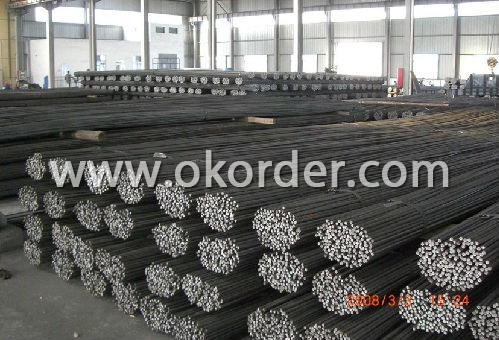
Usage and Applications of Construction Deformed Steel Rebar:
Deformed bar is widely used in buildings, bridges, roads and other engineering construction. Big to highways, railways, bridges, culverts, tunnels, public facilities such as flood control, dam, small to housing construction, beam, column, wall and the foundation of the plate, deformed bar is an integral structure material. With the development of world economy and the vigorous development of infrastructure construction, real estate, the demand for deformed bar will be larger and larger..
Packaging & Delivery of Construction Deformed Steel Rebar:
Packaging Detail: products are packed in bundle and then shipped by container or bulk vessel, deformed bar is usually naked strapping delivery, when storing, please pay attention to moisture proof. The performance of rust will produce adverse effect.
Payment terms: TT payment in advance or Irrevocable LC at sight.
Trade terms :FOB, CFR, CIF
Delivery Detail: within 45 days after received advanced payment or LC.
Note:
1. Our products are produced according to national standard (GB), if not, supply according to national standards (GB) or agreement as customer required.
2. Other Grade and Standard Deformed Steel Bar we can supply:
Grade: GR40/GR60, G460B/B500A/B500B/B500C,BST500S
Standard: ASTM, BS, DIN
The Minimum Order Quantity of these products is high, and need to be confirmed.
3. We can not only supply Deformed Steel Bar; if you need anything about building materials, please contact us for further information.
4. Please send us your detail specifications when inquire. We will reply to you as soon as possible. We sincerely hope we can establish a long stable business relationship.
- Q: Can steel rebars be used in tunnels and underground structures?
- Yes, steel rebars can be used in tunnels and underground structures. Rebars are commonly used in construction projects to reinforce concrete structures and provide additional strength and durability. In tunnels and underground structures, where stability and load-bearing capacity are crucial, steel rebars are often incorporated into the concrete walls, floors, and ceilings to enhance their structural integrity. The rebars help to distribute the load and resist potential cracks or deformations caused by the pressure from the surrounding soil or water. Moreover, steel rebars offer resistance against corrosion, making them suitable for underground environments where moisture and other corrosive elements may be present. Overall, steel rebars are an essential component in the construction of tunnels and underground structures, ensuring their safety and longevity.
- Q: How do steel rebars affect the overall thermal expansion of concrete structures?
- Steel rebars have a significant impact on the overall thermal expansion of concrete structures. Due to the difference in thermal expansion coefficients between steel and concrete, the rebars tend to expand and contract at a different rate compared to the surrounding concrete. This mismatch in thermal expansion can lead to internal stresses and potential cracking in the concrete. However, the presence of steel rebars also provides reinforcement and increases the tensile strength of the structure, which can help counteract these effects and enhance overall durability.
- Q: What are the factors that can cause corrosion in steel rebars?
- The corrosion of steel rebars can be influenced by several factors. Firstly, the exposure to moisture and oxygen is a significant contributor to the corrosion process. When the steel rebar's surface comes into contact with moisture, it triggers an electrochemical reaction with the oxygen in the air, resulting in the formation of rust. This reaction is sped up in environments with high humidity or continuous water exposure, like coastal areas or submerged structures. Another factor that can cause corrosion is the presence of chloride ions. These can be found in seawater, deicing salts, or industrial environments, and they can penetrate the protective oxide layer on the steel rebar, making it more susceptible to corrosion. Once the chloride ions reach the metal surface, they break down the passive film, which allows the corrosion process to happen more quickly. The pH level of the environment is also crucial. Steel rebars are more prone to corrosion in highly acidic or alkaline conditions. Acidic environments, such as those in industrial areas with high air pollution or chemical exposure, can corrode the steel rapidly. Conversely, alkaline conditions, often found in concrete structures due to the presence of cement, can create a highly alkaline environment on the rebar's surface, leading to the breakdown of the protective oxide layer and promoting corrosion. Additionally, the presence of other impurities or contaminants can accelerate the corrosion process. For example, sulfur compounds can react with the steel rebar, forming sulfide corrosion products that weaken the structure. Similarly, exposure to certain organic compounds or acids can also contribute to corrosion. Lastly, the design and maintenance of structures can also play a role in the corrosion of steel rebars. Inadequate concrete cover or poor quality concrete can make it easier for moisture and oxygen to reach the steel, increasing the chances of corrosion. Lack of proper maintenance, such as neglecting to repair cracked or damaged concrete, can also lead to water infiltration and subsequent corrosion of the rebars. In conclusion, factors like moisture and oxygen exposure, chloride ions, pH level, presence of contaminants, and insufficient design or maintenance can all contribute to the corrosion of steel rebars. It is vital to understand and address these factors to ensure the longevity and durability of structures that incorporate steel rebars.
- Q: Can steel rebars be used in structures with curved or irregular shapes?
- Yes, steel rebars can be used in structures with curved or irregular shapes. The flexibility and malleability of steel allow rebars to be bent and shaped according to the desired design, making it suitable for various architectural and engineering applications.
- Q: What is the role of steel rebars in load-bearing structures?
- The role of steel rebars in load-bearing structures is of utmost importance and has multiple aspects. In load-bearing structures like buildings, bridges, dams, and other infrastructure projects, steel rebars, also known as reinforcing bars, are used to reinforce and strengthen concrete structures. They are typically made from carbon steel and strategically positioned within the concrete to counteract its low tensile strength and enhance its ability to withstand tension and compression forces. Steel rebars serve several key functions in load-bearing structures: 1. Reinforcement: Concrete has excellent compressive strength but lacks tensile strength. Steel rebars are embedded in the concrete to absorb tensile forces and prevent the formation or propagation of cracks. By reinforcing the concrete, they help distribute and manage loads more effectively, ensuring the structural integrity and durability of the building. 2. Load distribution: Steel rebars help distribute the weight and load-bearing capacity of the structure more evenly. They assist in transferring applied loads, such as the weight of the structure itself, live loads, or environmental forces, to the foundation or other supporting components. This redistribution of forces prevents localized damage and ensures the structure can handle various external and internal loads. 3. Flexibility and ductility: Steel rebars provide flexibility and ductility to the concrete. This means that even when the structure is subjected to heavy loads, vibrations, or external forces, the rebars can absorb and distribute stress across the structure, minimizing the risk of failure. Steel rebars are particularly effective in earthquake-prone areas, where they help absorb and dissipate seismic energy. 4. Longevity and durability: By reinforcing the concrete, steel rebars significantly increase the longevity and durability of load-bearing structures. They help prevent cracking, shifting, and other structural issues that may arise due to aging, environmental factors, or excessive loading. This extended lifespan ensures the safety and stability of the structure over time. In conclusion, steel rebars play a vital role in load-bearing structures by providing reinforcement, enhancing load distribution, increasing flexibility, and improving the longevity and durability of the structure. Including steel rebars allows for the construction of safer, stronger, and more resilient buildings and infrastructure projects.
- Q: How are steel rebars coated with epoxy?
- Steel rebars are coated with epoxy through a process called epoxy coating or epoxy rebar coating. This process involves applying a layer of epoxy onto the surface of the steel rebar to provide protection against corrosion and other environmental factors. The first step in coating steel rebars with epoxy is to prepare the surface. This includes cleaning the rebars to remove any dirt, oil, or rust that may be present. Surface preparation is crucial as it ensures proper adhesion of the epoxy to the steel surface. Once the surface is prepared, the epoxy coating is applied. There are various methods for applying epoxy, including spraying, brushing, or dipping the rebars into an epoxy solution. The chosen method depends on factors such as the size and shape of the rebars, as well as the desired thickness of the epoxy coating. After the epoxy is applied, the rebars are left to cure. Curing is a process that involves allowing the epoxy to harden and reach its maximum strength. The curing time can vary depending on the specific epoxy product used, but it usually takes several hours or even days for the epoxy to fully cure. Once the epoxy coating is fully cured, the coated rebars are ready for use. The epoxy coating provides a protective barrier that helps prevent the steel rebars from rusting and deteriorating over time. It also improves the rebars' resistance to chemicals, moisture, and other corrosive substances. Overall, epoxy coating is an effective method for protecting steel rebars from corrosion and extending their lifespan. It is widely used in construction projects where rebars are exposed to harsh environmental conditions, such as bridges, buildings, and infrastructure projects.
- Q: How do steel rebars affect the shrinkage and creep behavior of concrete?
- The shrinkage and creep behavior of concrete are significantly impacted by steel rebars. Shrinkage occurs when concrete contracts as it dries and hardens, while creep refers to the long-term deformation of concrete under sustained load. The presence of steel rebars in concrete has two main effects on its overall shrinkage. Firstly, the rebars provide resistance against shrinkage by countering the tensile forces that arise during drying. This resistance limits the volume change of the concrete, minimizing shrinkage. Secondly, the rebars act as a barrier to moisture movement, thus restricting the drying and shrinkage of the concrete. Nevertheless, the addition of steel rebars can also influence the creep behavior of the concrete. Creep is influenced by the material's modulus of elasticity and strength, both of which can be altered by the presence of steel rebars. The high modulus of elasticity and strength of the rebars can lead to higher levels of creep in the concrete, as there can be differential deformation between the concrete and the steel. Furthermore, the bond between the rebars and the concrete also affects the creep behavior. The strength of this bond influences the transfer of stress from the concrete to the rebars, thereby impacting the overall creep behavior of the composite material. In conclusion, steel rebars can reduce concrete shrinkage by providing resistance against drying and limiting moisture movement. However, they can also influence the creep behavior of the concrete due to factors such as modulus of elasticity, strength, and bond strength between the rebars and the concrete. Understanding the interaction between steel rebars and concrete is essential for designing structures that can withstand shrinkage and creep effects.
- Q: How do steel rebars contribute to the overall sustainability of the construction industry?
- The construction industry benefits from steel rebars in several ways, which contribute to its overall sustainability. To begin with, the utilization of steel rebars improves the strength and longevity of concrete structures. This leads to reduced repair and replacement needs, resulting in less construction waste and a smaller environmental impact. Furthermore, steel rebars can be recycled and repurposed at the end of their life cycle. This not only decreases the demand for new steel production but also reduces energy consumption and greenhouse gas emissions associated with manufacturing. By embracing the circular economy, steel rebars help conserve natural resources and decrease the construction industry's carbon footprint. Moreover, incorporating steel rebars into concrete structures enhances their ability to withstand seismic activity and extreme weather conditions like hurricanes or earthquakes. This ensures the safety of occupants and minimizes the risk of infrastructure damage, thereby reducing the need for reconstruction and increasing overall resilience. Additionally, steel rebars can be engineered to optimize material usage and decrease the weight of structures. This leads to more efficient transportation and installation processes, resulting in lower fuel consumption and emissions related to transportation. Lastly, steel rebars offer flexibility in design and construction, enabling innovative and sustainable building solutions. They can easily be integrated into various construction methods, allowing for the use of sustainable techniques such as prefabrication or modular construction. This improves efficiency, reduces construction time, and minimizes disruption to the surrounding environment. In conclusion, steel rebars are essential for the sustainability of the construction industry. They enhance structure durability, promote recycling, reduce waste generation, conserve resources, improve safety, and enable innovative construction techniques. Their use contributes to the overall environmental, social, and economic sustainability of the industry, making them a vital component in sustainable construction practices.
- Q: What are the specifications of thread steel?
- Specification requirements for threaded steel shall be specified in the import and export trade contract.Generally should include the standard grade (type code), the nominal diameter of steel, nominal weight (quality), the length of the specifications and the allowable difference between the above indicators.
- Q: How are steel rebars used in the construction of dams?
- The construction of dams relies heavily on steel rebars, as they offer the necessary strength and stability to the structure. Dams, which are massive concrete constructions designed to contain water for various purposes like hydroelectric power generation, irrigation, and flood control, greatly benefit from the presence of steel rebars. Steel rebars, also referred to as reinforcing bars, are essential in reinforcing the concrete and enhancing its ability to withstand tension. Although concrete is excellent at withstanding compression, it is relatively weak when it comes to tension. This is where steel rebars come into play, as they are strategically positioned inside the concrete structure to counteract any tensile forces that may lead to cracks or failure. Typically, in the construction of dams, steel rebars are embedded within the concrete in a crisscross manner, forming a network of reinforcement. This configuration helps to evenly distribute the load and resist the immense pressure exerted by the water behind the dam. By reinforcing the concrete, steel rebars ensure that the dam can withstand various forces, including the weight of the water, water pressure, and external factors such as earthquakes. Moreover, steel rebars also serve to prevent cracks from spreading within the concrete. In the event of minor cracks caused by environmental factors or settlement, the rebars act as a barrier, preventing the cracks from expanding and compromising the structural integrity of the dam. To ensure their strength and durability, steel rebars used in dam construction must meet specific standards and specifications. Typically, they are made from high-strength steel capable of withstanding the immense pressures and forces encountered during dam construction. In conclusion, the presence of steel rebars is vital in the construction of dams as they reinforce the concrete, provide the necessary strength and stability, and prevent the propagation of cracks. Their strategic placement and configuration aid in load distribution, tension resistance, and the maintenance of the dam's structural integrity and reliability.
1. Manufacturer Overview
| Location | Hebei, China |
| Year Established | 2009 |
| Annual Output Value | Above US$ 500 Million |
| Main Markets | Southeast Asia; East Asia; Middle east |
| Company Certifications | ISO 9001:2008 |
2. Manufacturer Certificates
| a) Certification Name | |
| Range | |
| Reference | |
| Validity Period |
3. Manufacturer Capability
| a) Trade Capacity | |
| Nearest Port | Tianjin; |
| Export Percentage | 40%-60% |
| No.of Employees in Trade Department | 21-60 People |
| Language Spoken: | English; Chinese |
| b) Factory Information | |
| Factory Size: | Above 850,000 square meters |
| No. of Production Lines | Above 5 |
| Contract Manufacturing | OEM service offered |
| Product Price Range | high; average |
Send your message to us
Construction Deformed Steel Rebar
- Loading Port:
- China Main Port
- Payment Terms:
- TT or LC
- Min Order Qty:
- 25MT m.t.
- Supply Capability:
- 800000Tons m.t./month
OKorder Service Pledge
OKorder Financial Service
Similar products
Hot products
Hot Searches
Related keywords



